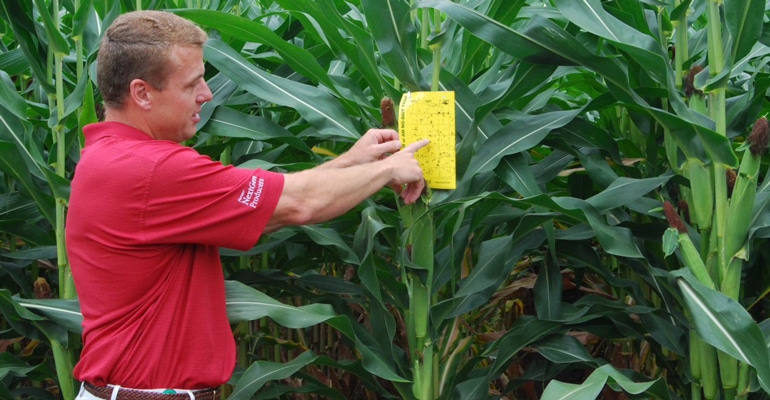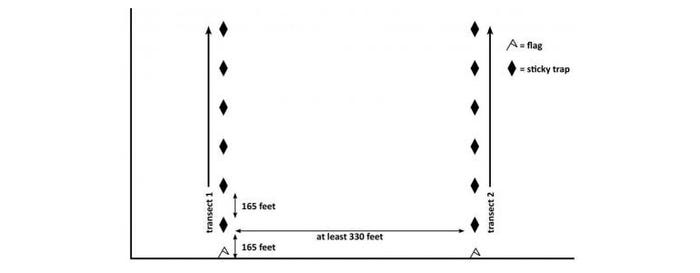July 29, 2019

Two species of rootworm are major corn pests in Iowa and surrounding states: the western corn rootworm and northern corn rootworm. Farmers have seen several management changes take place during the past 20 years to help control this insect. That includes new technology becoming available, such as the release of four Bt-rootworm traits in corn hybrids since 2003. The traits aim to suppress corn rootworm larvae that chew on corn roots.
When the rootworm larvae chew on roots of corn hybrids that have the Bt trait, the larvae die. But in some cases, the larvae survive because they have developed resistance to the trait. Thus, planting a Bt corn hybrid in areas of the state where this problem exists is no longer effective at providing rootworm control.
Western corn rootworm resistance
Both rootworm species — the western and the northern corn rootworm — are persistent pests, but western corn rootworm is particularly adaptable. It can develop resistance to the Bt traits, and that resistance has shown up in rootworm populations in some fields in Iowa. The Gassmann Lab at Iowa State University has confirmed that western corn rootworm has developed resistance to all of the Bt rootworm traits available in corn hybrids for planting in Iowa.

WESTERNS: Western corn rootworm beetles are black with yellow stripes, and lay eggs that hatch to produce rootworm larvae.

“To prolong the effectiveness of the Bt trait in corn hybrids to control corn rootworm, farmers should scout and monitor their fields during the summer. Look for the presence of corn rootworm and make management decisions based on rootworm larval injury to corn roots or based on the adult corn rootworm beetle activity,” says Erin Hodgson, Iowa State University Extension entomologist.
Hodgson adds, “We recommend using the 0 to 3 node-injury scale developed at ISU to evaluate rootworm larval injury to corn roots. Corn rootworm egg hatch peaked in mid-June this year, and the adult beetles are now beginning to emerge in many fields. The adult corn rootworm beetles lay eggs in the soil this summer, the eggs overwinter, and they hatch into rootworm larvae the following spring.”
Rootworm beetles can clip silks
Adult emergence coincided with silking in corn this year throughout much of Iowa. This can be problematic, as the adult beetles can clip silks and interfere with corn pollination, Hodgson says. To monitor for the presence of adult corn rootworm beetles in your fields, she suggests you follow the guidelines she has outlined below.

NORTHERNS: Northern corn rootworm beetles are green and lay eggs that hatch to produce rootworm larvae.

Use Pherocon AM yellow sticky traps (unbaited). Hodgson says you should set up sticky traps at corn silking time and continue with monitoring the sticky traps at least once a week through the dent stage of corn. That is, use the traps to monitor the beetle population from mid-July through August. For areas in eastern Iowa with suspected rotation-resistant western corn rootworm, you should set up sticky traps at the time of soybean flowering and continue through full seed set (mid-July through August).
There are fields in some areas of eastern Iowa where a simple corn-soybean crop rotation isn’t enough to avoid problems with corn rootworm. In these cases, the rootworms have adapted to the corn-bean rotation. They will survive in the soil the year the field is planted to soybeans. They will then chew on corn roots the year after soybeans are planted in the field in a corn-bean rotation.
Guidelines for sampling adult corn rootworm
Hodgson provides the following recommendations for sampling fields for corn rootworm beetles:
Transects. For every 10 to 50 acres of corn or soybeans, you should create two transects of six sticky traps per transect. Transects should be at least 330 feet apart. Use a flag or stake to mark transects along the field edge.
First trap. Place the first trap at least 165 feet in from the field edge; place remaining traps within the same row and at least 165 feet apart.
Placement. For corn, attach the sticky trap directly to the developing ear. For soybeans, attach the sticky trap to a post approximately 18 inches above the canopy.
Weekly check. Check traps weekly and count the number of western and northern corn rootworms. Replace sticky traps weekly and adjust trap height if needed.
Estimation. For each sample, estimate the average number of western and northern corn rootworms per trap per day. For example, 123 total corn rootworms per 12 traps per seven days equals 1.46 rootworms per trap per day.
Thresholds. Action thresholds in corn are two corn rootworms per trap per day, regardless of species. Consider crop rotation if action thresholds are met. That is, rotate that field to soybeans next year instead of planting it to corn again. If planting corn again in 2020, use a corn hybrid that has the pyramided Bt trait with Cry34/35Ab1, or use a soil-applied insecticide on non-rootworm Bt corn.
Action thresholds in soybeans are 1.5 western corn rootworms per trap per day. If action thresholds are met in soybeans, consider using a pyramided Bt trait or a soil-applied insecticide on non-rootworm Bt corn the following season.

GAME PLAN: This drawing shows how to place adult corn rootworm sticky traps in corn or soybean fields. Sticky traps are used to get an estimate of the number of adult corn rootworm beetles present in the field.

About the Author(s)
You May Also Like






